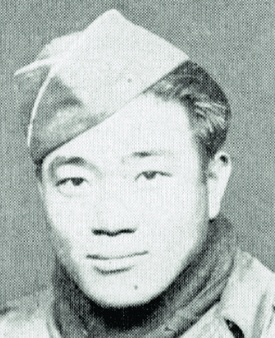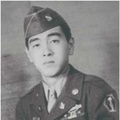Bertram Akira Tsunematsu was born in Waialua, O‘ahu, on Dec. 12, 1915. He was the eldest of three children of Masao and Hatsune (Uramoto) Tsunematsu, who emigrated from Kumamoto Prefecture, Japan. Masao arrived in December 1907 on the Siberia Maru. Hatsune arrived on the Tenyo Maru in 1914, and soon after arriving she and Masao were married at the U.S. Immigration Station in Honolulu. Masao worked for the Waialua Sugar Mill and by 1940 was working as a locomotive cleaner for the plantation.
At the age of 20, Akira went to Los Angeles where he enrolled in a trade school for auto mechanics. After graduating, he remained in the area and worked at an auto repair garage. He was drafted into the Army on Jan. 23, 1942, at Fort MacArthur. In early 1943 he was transferred to the 442nd Regimental Combat Team at Camp Shelby, Mississippi, and assigned to Company K.
While Akira trained for combat, his father Masao was one of the Waialua Plantation employees who formed a “Victory Unit” of Japanese immigrants determined to show their loyalty to the U.S. They aided in American Red Cross fundraising campaigns to help the war effort.
Tsunematsu followed the path of the other original members of the 442nd RCT – after a year of training they shipped out to the Mediterranean Theater in a large convoy of troop ships from Hampton Roads, Virginia, on May 2, 1944, and arrived at Naples, Italy, on May 28.
Akira fought in the Rome-Arno Campaign, driving the German Army north of the Arno River. In September 1944, the 442nd RCT was sent to Marseilles, France, where they were trucked 500 miles to the battlefront in northeastern France to join the Rhineland-Vosges Campaign.
The intense battles to liberate the important transportation junction of Bruyères and neighboring Biffontaine lasted nine days. The Combat Team was then put into reserve, but after only two days they were ordered to the front lines again to aid in the rescue of the Lost Battalion – the 1st Battalion of the 141st (Texas) Infantry Regiment. This battalion had gotten ahead of the lines and was surrounded on three sides by the enemy. Attempts by other units to free it had been unsuccessful, so the 442nd RCT was called in.
In the pursuit of the German forces following the rescue of the Texans, Akira was wounded in his thumb by hand grenade fragments in November 1944. He was treated and returned to duty.
After the intense and costly battles in the Vosges mountains, the 442nd RCT left on Nov. 19 by truck convoy for southern France. They remained in the area of Nice and Menton for several months – this was the Rhineland-Maritime Alps Campaign. The mission of the Combat Team was to protect the right flank of the 6th Army Group, and guard against a possible enemy breakthrough down the southern coast of France. Combat and reconnaissance patrols roamed back and forth between the lines.
During a patrol on Feb. 17, 1945, Corporal Bertram Akira Tsunematsu died after being hit in the abdomen and thorax by fragments from a land mine. He was buried in the U.S. Military Cemetery at Draguignan, about 60 miles from Nice. A memorial service was held for him by his parents and sisters on March 11, 1945, at the Waialua Hongwanji.
In 1948, the smaller wartime cemeteries in France were being closed and families were given the choice of having their loved one reinterred at the large U.S. Military Cemetery at Epinal or returned home. His family chose to bring Akira home.
Corporal Bertram Akira Tsunematsu arrived at Pearl Harbor on Dec. 24, 1948, on the USAT Sinnett with 121 other of Hawai‘i’s war dead. Over 700 relatives and friends were waiting on the pier where the fallen soldiers were eulogized in a shipside service by Secretary of Hawai‘i Oren E. Long.
“We are proud to have had such sons,” said Long. “These men stood the test of action and added a new chapter of American heroism to our history.” The caskets were then taken to the Army mausoleum at Schofield Barracks awaiting burial.
On May 30, 1949, Corporal Tsunematsu was among the sixteen war dead from Waialua and Kahuku who were memorialized in a ceremony at the Memorial Tower at Waialua Park in Hale‘iwa. It was sponsored by the Waialua Lions Club with the cooperation of the American Legion Post, 100th Infantry Battalion Veterans Club, 442nd Regimental Combat Team Veterans Club and Waialua National Guard. Corporal Bertram Akira Tsunematsu was then reinterred on Sept. 19, 1949, at the National Memorial Cemetery of the Pacific at Punchbowl.
*This article was originally published in The Hawai'i Herald on April 21, 2023.
© 2023 Sons & Daughters of the 442nd Regimental Combat Team





